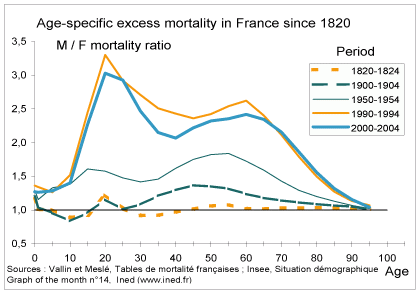Excess male mortality by age

Reading the graph
This graph shows the excess mortality of males with respect to females in France over the last 200 years.
Excess male mortality is measured as the male/female ratio of the probability of dying at a given age, for different groups of years from the early 19th century to the early 21st century: 1820-1824, 1900-1904, 1950-1954, 1990-1994 and 2000-2004.
For each age x, the five-year probabilities of dying between age x and age x+5 are used. For age 0 the male/female ratio is based on the infant mortality rate (from age 0 to 1 year) and for age 1, on that of mortality between ages 1 and 5 years.
The female advantage has increased over the last two centuries, but is now starting to narrow
Around 1820, life expectancy was 39 years for women and 38 years for men. Infant mortality was 30% higher for boys than for girls, while female mortality overtook that of males between ages 5 and 18 and at reproductive ages.
From 1860, mortality started falling, faster for females than for males, and the life expectancy gap between men and women began to widen. In 1900, excess female mortality was still observed at young ages, and male excess mortality was higher at age 50 than during the first year of life. During the 20th century, male excess mortality became more pronounced, first at later ages and then at around age 20. In the early 1990s, the male probability of dying between ages 15 and 70 was 2.5 times higher than that of women of the same age, with the male/female mortality ratio reaching 3.3 at ages 20-25.
Since the mid 1990s, male excess mortality has been decreasing in France and in most industrialized countries.
Sources
- Vallin J., Meslé F., 2001, Tables de mortalité françaises pour les XIXe et XXe siècles et projections pour le XXIe siècle
- La courbe 2000-2004 est calculée à partir des données publiées par l’Insee dans la Situation démographique en 2001 et en 2005
